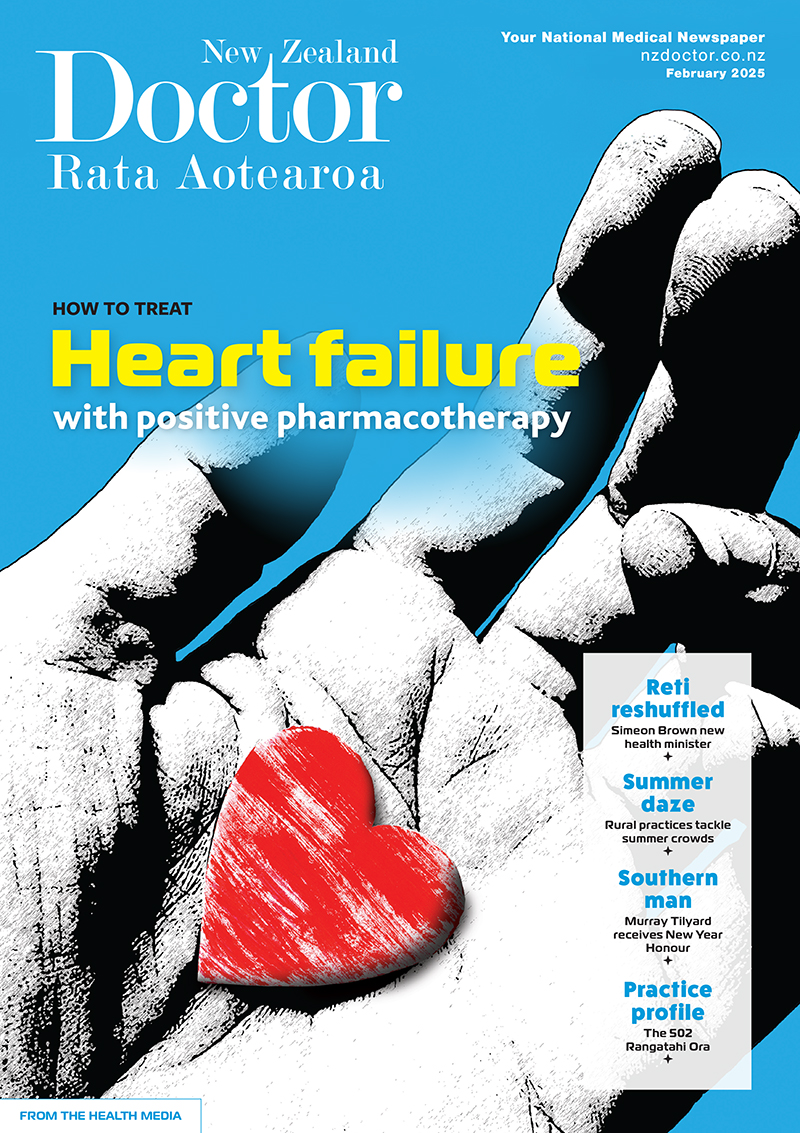Pharmacist prescribers Linda Bryant and Leanne Te Karu discuss positive polypharmacy for heart failure. Current evidence shows the intensive implementation of four medications offers the greatest benefit to most patients with heart failure, with significant reductions in cardiovascular mortality, heart failure hospitalisations and all-cause mortality
Reduce hospitalisations with COVID-19 antivirals
Reduce hospitalisations with COVID-19 antivirals

This article weighs up the benefits and risks of the two oral antiviral medicines currently available for early treatment of COVID-19
As we went to press, Pharmac announced that, effective from 18 July, the COVID-19 antiviral access criteria widened to include all people aged 75 and over, and those who have been admitted previously to an intensive care unit directly as a result of COVID-19. The number of factors Māori and Pacific peoples are required to have also reduced. Keep abreast of the Pharmac access criteria at: tinyurl.com/AntiviralAccess
This article has been endorsed by the RNZCGP and has been approved for up to 0.25 CME credits for continuing professional development purposes (1 credit per learning hour). To claim your credits, log in to your RNZCGP dashboard to record this activity in the CME component of your CPD programme.
Nurses may also find that reading this article and reflecting on their learning can count as a professional development activity with the Nursing Council of New Zealand (up to 0.25 PD hours).
In your peer group, the issue of prescribing medicines for COVID-19 is raised, as the local results suggest nirmatrelvir with ritonavir (Paxlovid) is being underused in those at higher risk for hospitalisation (Māori, Pacific and disabled communities), thereby increasing inequity.
While dispensing data suggest there is population parity with ethnicity data, this may not be appropriate for the burden of need. For example, dispensing data indicate Māori received approximately 16 per cent of nirmatrelvir/ritonavir courses to 1 June, yet made up 22 per cent of all hospitalised cases (Table 1).1
In terms of mortality, the most profound inequities are seen in death rates in younger age groups, where Māori aged 59 and younger make up 41.4 per cent of deaths within 28 days of case identification.
When choosing case studies to workshop, it is decided to use the first four patients in your practice who contracted COVID-19 after nirmatrelvir/ritonavir became available.
Please read the following cases and think about whether you would prescribe nirmatrelvir/ritonavir or molnupiravir (Lagevrio), then read the discussion.
Case A – a fully vaccinated, 83-year-old Māori man with type 2 diabetes, who had a myocardial infarction 17 years ago. He has a BMI of 36kg/m2 and is on rosuvastatin. He contracted the virus from his son, and he had a positive rapid antigen test yesterday.
Case B – a 59-year-old unvaccinated man of European descent in supported living, on quetiapine 300mg daily. He also takes atorvastatin and losartan, and has a cardiovascular risk of 15 per cent. He has had symptoms for two days and did a RAT today, which was positive.
Case C – a 61-year-old woman of European descent, with seasonal asthma and a BMI of 31kg/m2. She is triple vaccinated and lives with her husband and adult daughter. She has had symptoms for three to four days and is requesting a salbutamol inhaler.
Case D – a 45-year-old Pacific woman with pre-diabetes and a BMI of 33kg/m2. She is double vaccinated and makes contact with you on day five since symptom onset because she wants some medicine for her headache. She is hesitant about taking medicines.
Currently, two oral medicines are available in Aotearoa New Zealand for early intervention to reduce the chance of hospitalisation due to COVID-19. In people who have tested positive for COVID-19 and who are at high risk of hospitalisation, it is important to use these medicines within five days, and preferably within three days, of symptom onset.
Unfortunately, due to media hype, some people have an unrealistic expectation about the benefit of these “super drugs”, expecting a simple “cure” for everyone with COVID-19, leading to potential overtreatment of the worried well. Conversely, there appears to be less use of these medicines in people who are most likely to benefit.
Nirmatrelvir is an oral protease inhibitor that blocks the activity of the protease enzyme required for SARS-CoV-2 replication. Clinicians are usually more familiar with the concept of protease inhibitors in their use for HIV infections.
Ritonavir is used to inhibit metabolism of nirmatrelvir by cytochrome P450 3A4 (CYP3A4), and thus achieve therapeutic concentrations. This is the component that causes medicine interactions that may be problematic.
The media emphasises a 70 to 80 per cent relative risk reduction for hospitalisation or death, but this was in a study population of unvaccinated people with at least one other risk factor for disease progression or hospitalisation, at a time when 98 per cent of COVID-19 cases were due to the Delta variant.2
In the EPIC-HR trial, the rate of hospitalisation or death for the placebo group was 6.3 per cent, and the rate for the nirmatrelvir/ritonavir group was 0.8 per cent. The relative risk reduction was 89 per cent, but the absolute risk reduction was 5.5 per cent, providing a number needed to treat (NNT) of 18 unvaccinated people who have another risk factor.2
Translating this to New Zealand, with the Omicron variant and a hospitalisation rate of 4.5 per cent for unvaccinated people and 0.5 per cent for vaccinated people,3 the NNT to prevent one hospitalisation or death is an estimated 25 and 222, respectively (Table 2).
Although effective, particularly for people at high risk of hospitalisation with COVID-19, care is required with nirmatrelvir/ritonavir because of the ritonavir component. Inhibition of the CYP3A4 enzyme system, to prevent rapid inactivation of the nirmatrelvir, means that it can also inhibit the metabolism of other medicines predominantly metabolised by CYP3A4, of which there are many.
A straightforward website provided by the University of Liverpool (covid19-druginteractions.org) enables rapid identification of potential interactions and includes a three-page colour chart for printing. For many interacting medicines, a one-week discontinuation (eg, statin) or dose reduction (eg, risperidone) is unlikely to have a large clinical impact.
Experience with the hepatitis C virus and HIV has raised awareness of the risk of viral resistance to monotherapy with antivirals. Nirmatrelvir/ritonavir is relatively new, and there is ongoing monitoring of resistance, with no significant concerns as yet.
There have been reports of viral load rebound a median of nine days after treatment in approximately 1 per cent of people. However, this does not appear to be associated with recurrence of severe disease or mutations.4,5
The principles of antimicrobial stewardship mean that nirmatrelvir/ritonavir should be used for those at risk of COVID-19 hospitalisation and not for low-risk people.
With renal dysfunction, nirmatrelvir/ritonavir is contraindicated at an estimated glomerular filtration rate of <30ml/min, and the dose should be reduced to one of each tablet twice daily at an eGFR of ≥30 to <60ml/min.
Note that the daily blister card contains two parts, each containing two tablets of nirmatrelvir and one tablet of ritonavir. People need to know which one to stop. They can take the unused nirmatrelvir back to the pharmacy but should not put them into a waterway (eg, down the sink).
Molnupiravir is a nucleoside analogue that is incorporated into the viral RNA when it replicates, thereby introducing errors. This genetic error prevents further virus replication, thus decreasing the viral load.
In the MOVe-OUT study, molnupiravir was used within five days of COVID-19 symptom onset in unvaccinated people with at least one risk factor for severe COVID-19, when the Delta variant predominated. Treatment was started within three days of symptom onset for 48 per cent of participants, which provided a greater benefit than when started at four or five days.6
At 29 days, 9.7 per cent in the placebo group were hospitalised or died, compared with 6.8 per cent of the molnupiravir-treated group, giving a 30 per cent relative risk reduction and a 2.9 per cent absolute risk reduction. The NNT to prevent one hospitalisation or death was 33.6
Applying this to the New Zealand hospitalisation rates as described above, the NNT to prevent one hospitalisation or death in the unvaccinated and vaccinated populations is an estimated 67 and 667, respectively (Table 3).
No dose adjustment is necessary for renal impairment.
Note that at the time of publication, it has been indicated that molnupiravir may become available on a self-funded basis, again increasing the possibility of inequity. However, people should also be informed of the NNT to help them make their decision.
Nirmatrelvir/ritonavir has demonstrated efficacy. However, in the New Zealand environment, with 95 per cent of the population vaccinated and having Omicron as the predominant variant, the NNT is conceivably much higher than in the clinical trial.
Despite best-laid plans, the early surge of COVID-19 occurred before these medicines were readily available, which has limited their usage. It has also been observed that many people do not upload their positive test results, so by the time the person is identified, symptoms have been present for longer than five days.
Your peer group discusses a strategy for going forward. First, identify people who would likely qualify for treatment with antiviral medicines, such as unvaccinated people, Māori or Pacific peoples, and older people (see panel) who have not yet had COVID-19. Provide them with a box of RATs so they can test at the first sign of an infection, and they will know to contact the practice within 24 hours.
For these people, use the Pharmac antiviral access criteria assessment tool (tinyurl.com/AntiviralAccessTool) or the heat map (see figure) and review them clinically, including current medicines. These criteria may change with the uptake of these medicines being less than predicted.
Check the University of Liverpool’s COVID-19 Drug Interactions website (covid19-druginteractions.org). Balance the potential benefit of nirmatrelvir/ritonavir versus the need for changing long-term medicines and patient perspective. Options include one of the following:
- Stop the target medicine for seven days (five days treatment plus two days to “remove” the enzyme inhibition effect of ritonavir).
- Reduce the dose of the target medicine, with monitoring (eg, risperidone), using if-needed dosing as cover.
If neither of these options is feasible, consider referral for remdesivir (an intravenous nucleoside analogue), although this requires initiation within seven days of symptom onset, or oral molnupiravir.
- Unvaccinated – a priority group.
- Māori or Pacific – a priority group.
- Age ≥50 (Māori or Pacific) or ≥65 (European) – increasing priority with increasing age.
- A high-risk medical condition, including a mental health diagnosis and social complexity.
Case A – yes, nirmatrelvir/ritonavir is suitable, even though he is fully vaccinated, because of age (over 65) and ethnicity (Māori) as the primary drivers, plus he has diabetes, cardiovascular disease and a BMI >35kg/m2. His statin should be stopped for seven days.
Case B – yes, nirmatrelvir/ritonavir is suitable because, being unvaccinated, this patient is at high risk, plus he has high cardiovascular risk and a mental health condition. Atorvastatin can be stopped for one week. Ritonavir may increase serum quetiapine levels up to six times. If well controlled, the quetiapine dose could be reduced to 50mg for eight days with monitoring for sedation or increased anxiety.
Case C – the NNT to prevent a hospitalisation is high, and this patient is not at high risk. Inhaled budesonide 800µg twice daily for 14 days was found to shorten recovery time from 15 to 12 days when the Delta variant dominated. This patient should use a high dose of her inhaled corticosteroid for at least two weeks. Emphasise this if she has a history of erratic adherence.
Case D – she will likely obtain less benefit from treatment with nirmatrelvir/ritonavir than if she had presented within three days. She has some factors for increased risk (eg, ethnicity) but is otherwise low risk and would not currently qualify for funded supply. A discussion would be helpful to present the benefit (NNT) and that antiviral treatment is unlikely to help her headache.
Details have been changed to protect patient confidentiality
Linda Bryant is a pharmacist prescriber at Newtown Union Health Service and Porirua Union and Community Health Service, Wellington; Leanne Te Karu is a pharmacist prescriber at Pihanga Health in Tūrangi
For more on prescribing COVID-19 antivirals, see “Heartbeat” this issue and akohiringa.co.nz/tags/covid-19
You can use the Capture button below to record your time spent reading and your answers to the following learning reflection questions:
- Why did you choose this activity (how does it relate to your PDP learning goals)?
- What did you learn?
- How will you implement the new learning into your daily practice?
- Does this learning lead to any further activities that you could undertake (audit activities, peer discussions, etc)?
We're publishing this article as a FREE READ so it is FREE to read and EASY to share more widely. Please support us and the hard work of our journalists by clicking here and subscribing to our publication and website
1. Ministry of Health. COVID-19: Case demographics. 1 June 2022. https://www.health.govt.nz/covid-19-novel-coronavirus/covid-19-data-and-statistics/covid-19-case-demographics#aug-2021
2. Hammond J, Leister-Tebbe H, Gardner A, et al. Oral nirmatrelvir for high-risk, nonhospitalized adults with Covid-19. N Engl J Med 2022;386(15):1397–408
3. Duffy E. Treating COVID-19 with Paxlovid in primary care. 31 March 2022. https://www.akohiringa.co.nz/education/treating-covid-19-with-paxlovid-in-primary-care
4. Ranganath N, O’Horo JC, Challener DW, et al. Rebound phenomenon after nirmatrelvir/ritonavir treatment of coronavirus disease-2019 in high-risk persons. Clin Infect Dis 2022:ciac481.
5. Soares H, Baniecki ML, Cardin R, et al. Viral load rebound in placebo and nirmatrelvir-ritonavir treated COVID-19 patients is not associated with recurrence of severe disease or mutations. [Preprint] https://doi.org/10.21203/rs.3.rs-1720472/v1
6. Jayk Bernal A, Gomes da Silva MM, Musungaie DB, et al. Molnupiravir for oral treatment of Covid-19 in nonhospitalized patients. N Engl J Med 2022;386(6):509–20.








